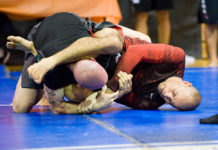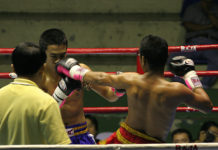You’ve probably heard about the BJJ vs Karate debate…
BJJ and Karate are both popular martial arts and widely available in most Western countries.
Although Karate was way cooler in the 80s than it is now, with the rise of Karate fighters such as Stephen ‘Wonderboy’ Thompson and other high-profile Karate-kas, Karate is still a very prominent martial art.
When it comes to assessing BJJ vs Karate, we looked at the benefits in terms of strength, weight loss, and self defense. The following article compares these two arts to give you the low-down on the benefits and features of each.
What is Karate?
Karate is a Japanese martial art that incorporates a variety of strikes, in particular, punches and kicks, into its curriculum. In many ways, Karate is not a single martial art.
With dozens of styles ranging from American Kenpo to Okinawan Karate and kyokushin Karate, the specific techniques, competition rulesets, and training emphasis will vary to a much greater degree than in BJJ, which despite the range of schools is generally universal in terms of techniques.
In general, Karate is a striking art that may include some grappling techniques but not always. Additionally, Karate incorporates a lot of traditional training requirements for promotion such as learning Japanese terms and performing kata, which are choreographed solo move sequences.
BJJ vs Karate for Strength

Both BJJ and Karate involve athleticism and strength, however the specific strength required does vary between the two arts.
BJJ strength: slow, isometric, explosive
Grappling requires you to exert steady force against resisting opponents, hold maintain ‘holding force’ without actually visibly moving, and intermittently explode in transitions.
Pushing into an opponent or framing against an opponent are both examples of isometric strength, where you are stiffening up your muscles to block or push, but are not moving very much throughout that exertion.
The burn you feel in your forearms after a choke attempt is the result of the extended isometric muscle contraction of your forearm muscles as you try to squeeze your opponent’s neck.
Gripping in general is heavily dependent on isometric strength. Whether Gi or No Gi, you’ll need a strong grip.
There is also explosive strength required, where you rapidly accelerate to change position, take your opponent down, pass guard, and other fast paced scramble situations in BJJ.
Therefore, BJJ requires a range of strength types.
Karate strength: explosive
Karate on the other hand primarily revolves around striking. As such, the need for that isometric ‘squeeze contraction’ is much lower, particularly if the style of Karate does not involve any clinching.
The explosive force for punches and kicks relies on rapidly accelerating your body, and requires more power but shorter durations than the isometric strength needed in BJJ.
Karate will primarily develop explosive strength and power, with a much lower emphasis on the isometric strength needed in BJJ.
Weight Loss in Karate and BJJ
Many people start martial arts as a method to lose weight. Both Karate and BJJ can be effective for weight loss, as each art involves physical activity that burns calories.
Unfortunately, regardless of the activity you choose for weight loss, you need to ensure you are eating fewer calories than you burn throughout the day or all efforts at weight loss will be null and void.
The specific number of calories you burn in each art varies heavily with the intensity and duration of your training. If you are sparring live in either art, you will a lot of calories.
The calories burned during drilling in each art varies substantially with the intensity. Slow paced technique drilling will not burn many calories. On the other hand, fast paced drilling in either art will add up to a substantial number of calories burned.
If you were to theoretically spar with intensity for an hour in either art, you would burn upwards of 900 calories. Adjusting the intensity downwards will burn proportionally fewer calories.

Self Defense: BJJ vs Karate
When it comes to self defense, there are few clear cut answers as to the best martial art style.
BJJ has a number of advantages and several shortcomings for self defense, however the techniques found in grappling are certainly useful and necessary skills for complete self defense toolkit.
Karate offers the benefit of knowing striking, which can come in handy in a fight. However, the lack of sophisticated grappling in much of mainstream Karate means that there is a substantial hole in the effectiveness of Karate for complete self defense.
Additionally, both arts suffer from the standard lack of situational awareness, weapons training, and legal and medical aspects of real-world violence that you truly need for a complete self defense system.
If you had to pick a single art to train, BJJ is the better choice simply because it prepares you for the worst-case scenario of having a bad guy on top of you pinning you down.
While striking is useful in a fight, if you are standing in striking range, you can probably still run away. On the other hand, if you are on the bottom and fully mounted, you have one choice: use BJJ to escape.
Karate vs BJJ: the bottom line
Karate and BJJ are both effective martial arts for a variety of purposes ranging from strength to weight loss and self defense.
Each art certainly has its benefits and shortcomings, and regardless of which art you choose, a qualified instructor is an absolute must.
If you are on the fence about Karate vs BJJ, your best bet is try out both arts and see which one you prefer.
You can always double up on your training to get the benefits of both Karate and BJJ.
If you end up finding one art more interesting, double down on it and focus on what you prefer.
Style versus style will always be a subjective debate, and the most important thing is that you actually enjoy your training.
Explore similar topics:
Explore other topics:
- The Best BJJ Strength and Conditioning Program
- Essential No Gi BJJ Gear
- The Best Jiu Jitsu Documentaries





